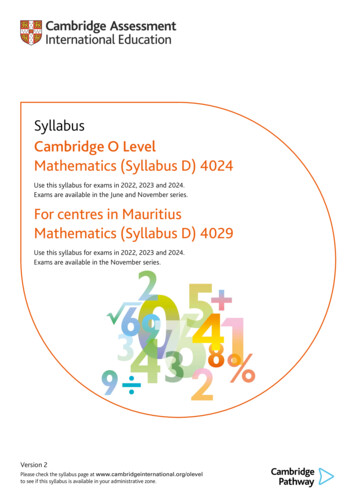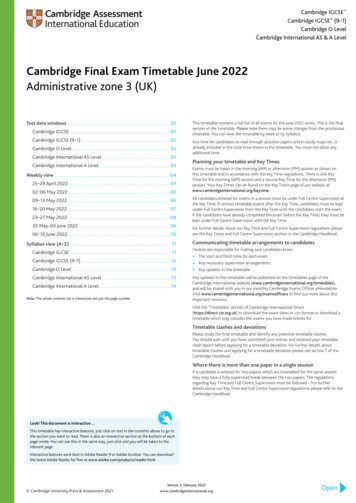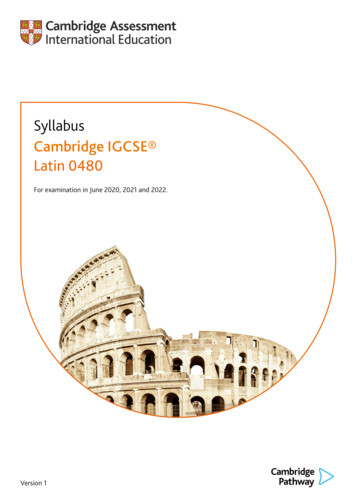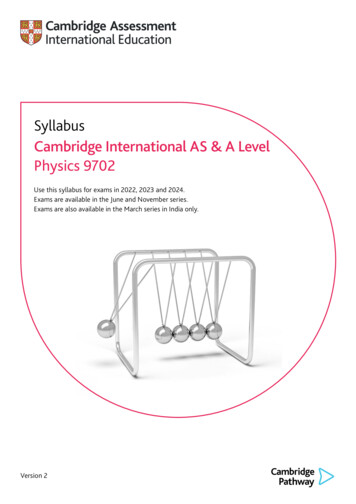
Transcription
SyllabusCambridge O LevelMathematics (Syllabus D) 4024Use this syllabus for exams in 2022, 2023 and 2024.Exams are available in the June and November series.For centres in MauritiusMathematics (Syllabus D) 4029Use this syllabus for exams in 2022, 2023 and 2024.Exams are available in the November series.Version 2Please check the syllabus page at www.cambridgeinternational.org/olevelto see if this syllabus is available in your administrative zone.
Changes to the syllabus for 2022, 2023 and 2024The latest syllabus is version 2, published February 2021.The syllabus has been republished to correct a font issue, where mathematical symbols were notdisplaying correctly in the syllabus content.There are no significant changes to content which affect teaching, beyond the correction of mathematicalsymbols where needed.Changes made to version 1 of the syllabus, published September 2019There were no significant changes which affected teaching.You are strongly advised to read the whole syllabus before planning your teaching programme.Any textbooks endorsed to support the syllabus for examination from 2018 are still suitable foruse with this syllabus.Copyright UCLES September 2019Cambridge Assessment International Education is part of the Cambridge Assessment Group. Cambridge Assessment isthe brand name of the University of Cambridge Local Examinations Syndicate (UCLES), which itself is a department of theUniversity of Cambridge.UCLES retains the copyright on all its publications. Registered centres are permitted to copy material from this booklet fortheir own internal use. However, we cannot give permission to centres to photocopy any material that is acknowledged to athird party even for internal use within a centre.
Contents1. Introduction. 21.11.21.31.4Why choose Cambridge International?Why choose Cambridge O Level?Why choose Cambridge O Level Mathematics?How can I find out more?2. Teacher support. 52.1 Support materials2.2 Endorsed resources2.3 Training3. Syllabus content at a glance. 64. Assessment at a glance. 75. Syllabus aims and assessment objectives. 95.1 Syllabus aims5.2 Assessment objectives5.3 Relationship between assessment objectives and components6. Syllabus content. 117. Mathematical notation. 228. Other information. 27
Introduction1.Introduction1.1Why choose Cambridge International?Cambridge International prepares school students for life, helping them develop an informed curiosity and alasting passion for learning. We are part of the University of Cambridge.Our Cambridge Pathway gives students a clear path for educational success from age 5 to 19. Schools canshape the curriculum around how they want students to learn – with a wide range of subjects and flexibleways to offer them. It helps students discover new abilities and a wider world, and gives them the skillsthey need for life, so they can achieve at school, university and work.Our programmes and qualifications set the global standard for international education. They are createdby subject experts, rooted in academic rigour and reflect the latest educational research. They provide astrong platform for students to progress from one stage to the next, and are well supported by teaching andlearning resources.Every year, nearly a million Cambridge learners from 10 000 schools in 160 countries prepare for their futurewith the Cambridge Pathway.Cambridge learnersOur mission is to provide educational benefit through provision of international programmes andqualifications for school education and to be the world leader in this field. Together with schools, wedevelop Cambridge learners who are: confident in working with information and ideas – their own and those of others responsible for themselves, responsive to and respectful of others reflective as learners, developing their ability to learn innovative and equipped for new and future challenges engaged intellectually and socially, ready to make a difference.RecognitionOur expertise in curriculum, teaching and learning, and assessment is the basis for the recognition of ourprogrammes and qualifications around the world.Cambridge O Level is internationally recognised by schools, universities and employers as equivalent indemand to Cambridge IGCSE (International General Certificate of Secondary Education). There are over700 000 entries a year in nearly 70 countries. Learn more at e Assessment International Education is an education organisation and politically neutral. Thecontent of this syllabus, examination papers and associated materials do not endorse any political view.We endeavour to treat all aspects of the exam process neutrally.2Cambridge O Level Mathematics (Syllabus D) 4024/4029. Syllabus for examination in 2022, 2023 and 2024.
IntroductionSupport for teachersA wide range of materials and resources is available to support teachers and learners in Cambridge schools.Resources suit a variety of teaching methods in different international contexts. Through subject discussionforums and training, teachers can access the expert advice they need for teaching our qualifications. Moredetails can be found in Section 2 of this syllabus and at www.cambridgeinternational.org/teachersSupport for exams officersExams officers can trust in reliable, efficient administration of exams entries and excellent personal supportfrom our customer services. Learn more at www.cambridgeinternational.org/eoguideQuality managementCambridge International is committed to providing exceptional quality. In line with this commitment, ourquality management system for the provision of international qualifications and education programmesfor students aged 5 to 19 is independently certified as meeting the internationally recognised standard,ISO 9001:2015. Learn more at www.cambridgeinternational.org/ISO90011.2 Why choose Cambridge O Level?Cambridge O Level is typically for 14 to 16 year olds and is an internationally recognised qualification.It has been designed especially for an international market and is sensitive to the needs of differentcountries. Cambridge O Level is designed for learners whose first language may not be English, and this isacknowledged throughout the examination process.Our aim is to balance knowledge, understanding and skills in our programmes and qualifications to enablestudents to become effective learners and to provide a solid foundation for their continuing educationaljourney.Through our professional development courses and our support materials for Cambridge O Levels, weprovide the tools to enable teachers to prepare students to the best of their ability and work with us in thepursuit of excellence in education.Cambridge O Levels are considered to be an excellent preparation for Cambridge International AS & A Levels,the Cambridge AICE (Advanced International Certificate of Education) Diploma, Cambridge Pre-U, and othereducation programmes, such as the US Advanced Placement program and the International BaccalaureateDiploma programme. Learn more about Cambridge O Levels at www.cambridgeinternational.org/olevelGuided learning hoursCambridge O Level syllabuses are designed on the assumption that learners have about 130 guided learninghours per subject over the duration of the course, but this is for guidance only. The number of hours requiredto gain the qualification may vary according to local curricular practice and the students’ prior experience ofthe subject.Cambridge O Level Mathematics (Syllabus D) 4024/4029. Syllabus for examination in 2022, 2023 and 2024.3
Introduction1.3 Why choose Cambridge O Level Mathematics?Cambridge O Levels are established qualifications that keep pace with educational developments andtrends. The Cambridge O Level curriculum places emphasis on broad and balanced study across a widerange of subject areas. The curriculum is structured so that learners attain both practical skills and theoreticalknowledge.Cambridge O Level Mathematics is recognised by universities and employers throughout the world as proofof mathematical knowledge and understanding. Cambridge O Level Mathematics allows learners to gainlifelong benefits, including: confidence in their mathematical knowledge, and the ability to apply it in different contexts skills in communication and reasoning using mathematical concepts a solid foundation for further study the ability to be reflective when considering, presenting and interpreting mathematical results the ability to be engaged intellectually by developing a feel for numbers, patterns and relationships the ability to be innovative when applying their knowledge and understanding to solve problems in theirfuture work.Learners may also study for a Cambridge O Level in Additional Mathematics and for a Cambridge O Levelin Statistics. In addition to Cambridge O Levels, Cambridge also offers Cambridge IGCSE and CambridgeInternational AS and A Levels for further study in mathematics. See www.cambridgeinternational.org fora full list of the qualifications you can take.Prior learningWe recommend that learners who are beginning this course should have previously studied an appropriatelower secondary mathematics programme.ProgressionCambridge O Levels are general qualifications that enable candidates to progress either directly toemployment, or to proceed to further qualifications. Candidates who are awarded grades C to A* inCambridge O Level Mathematics are well prepared to follow courses leading to Cambridge InternationalAS & A Level Mathematics, or the equivalent.1.4 How can I find out more?If you are already a Cambridge schoolYou can make entries for this qualification through your usual channels. If you have any questions, pleasecontact us at info@cambridgeinternational.orgIf you are not yet a Cambridge schoolLearn about the benefits of becoming a Cambridge school at www.cambridgeinternational.org/startcambridgeEmail us at info@cambridgeinternational.org to find out how your organisation can register to become aCambridge school.4Cambridge O Level Mathematics (Syllabus D) 4024/4029. Syllabus for examination in 2022, 2023 and 2024.
Teacher support2.Teacher support2.1 Support materialsYou can go to our public website at www.cambridgeinternational.org/olevel to download current andfuture syllabuses together with specimen papers or past question papers, examiner reports and gradethreshold tables from one series.For teachers at registered Cambridge schools a range of additional support materials for specific syllabusesis available online from the School Support Hub. Go to www.cambridgeinternational.org/support(username and password required). If you do not have access, speak to the School Support coordinator atyour school.2.2 Endorsed resourcesWe work with publishers who provide a range of resources for our syllabuses including print and digitalmaterials. Resources endorsed by Cambridge International go through a detailed quality assurance processto make sure they provide a high level of support for teachers and learners.We have resource lists which can be filtered to show all resources, or just those which are endorsed byCambridge International. The resource lists include further suggestions for resources to support teaching.See centre for further information.2.3 TrainingWe offer a range of support activities for teachers to ensure they have the relevant knowledge and skills todeliver our qualifications. See www.cambridgeinternational.org/events for further information.Cambridge O Level Mathematics (Syllabus D) 4024/4029. Syllabus for examination in 2022, 2023 and 2024.5
Syllabus content at a glance3.Syllabus content at a glanceAll candidates will study the following themes or topics:6Theme or topicTheme or topic1. Number22. Sequences2. Set language and notation23. Variation3. Squares, square roots, cubes and cube roots24. Graphs in practical situations4. Directed numbers25. Graphs of functions5. Vulgar and decimal fractions and percentages26. Function notation6. Ordering27. Coordinate geometry7. Standard form28. Geometrical terms8. The four operations29. Geometrical constructions9. Estimation30. Similarity and congruence10. Limits of accuracy31. Symmetry11. Ratio, proportion, rate32. Angles12. Percentages33. Loci13. Use of an electronic calculator34. Measures14. Time35. Mensuration15. Money36. Trigonometry16. Personal and small business finance37. Vectors in two dimensions17. Algebraic representation and formulae38. Matrices18. Algebraic manipulation39. Transformations19. Indices40. Probability20. Solutions of equations and inequalities41. Categorical, numerical and grouped data21. Graphical representation of inequalities42. Statistical diagramsCambridge O Level Mathematics (Syllabus D) 4024/4029. Syllabus for examination in 2022, 2023 and 2024.
Assessment at a glance4.Assessment at a glanceAll candidates take two papers: Paper 1 and Paper 2.Each paper may contain questions on any part of the syllabus and questions may assess more than onetopic.Paper 12 hoursPaper 1 has approximately 25 short answer questions.Candidates should show all working in the spaces provided on the question paper. Essential workingmust be shown for full marks to be awarded.No calculators are allowed for this paper.80 marksThis paper will be weighted at 50% of the total qualification.Paper 22 hours 30 minutesPaper 2 has approximately 11 structured questions.Candidates should answer all questions.Electronic calculators may be used and candidates should have access to a calculator for thispaper.Candidates should show all working in the spaces provided on the question paper. Essential workingmust be shown for full marks to be awarded.100 marksThis paper will be weighted at 50% of the total qualification.Availability4024 is examined in the June and November examination series.4029 is examined in the November examination series.This syllabus is available to private candidates.Detailed timetables are available from www.cambridgeinternational.org/timetablesCambridge O Levels are available to centres in administrative zones 3, 4 and 5.Cambridge O Level Mathematics (Syllabus D) 4024/4029. Syllabus for examination in 2022, 2023 and 2024.7
Assessment at a glanceCombining this with other syllabusesCandidates can combine this syllabus in an examination series with any other Cambridge Internationalsyllabus, except:Candidates can combine syllabus 4024 in an examination series with any other Cambridge syllabus, except: syllabuses at the same level with the same title (‘Mathematics’, including ‘International Mathematics’)Candidates can combine syllabus 4029 in an examination series with any other Cambridge syllabus, except: syllabuses at the same level with the same title (‘Mathematics’, including ‘International Mathematics’)Please note that Cambridge O Level, Cambridge IGCSE and Cambridge IGCSE (9–1) syllabuses are at thesame level.Additional materials for examinations:For both Paper 1 and Paper 2, candidates should have these geometrical instruments: a pair of compasses a protractor a ruler.Tracing paper may be used as an additional material for both of the written papers.For Paper 2, candidates should have an electronic calculator – see below for details.Use of calculators:Paper 1 – the use of all calculating aids is prohibited.Paper 2 – all candidates should have a silent electronic calculator. A scientific calculator with trigonometricfunctions is strongly recommended. Algebraic or graphical calculators are not permitted.The General Regulations concerning the use of electronic calculators are contained in the CambridgeHandbook.Unless stated otherwise within an individual question, three-figure accuracy will be required. This meansthat four-figure accuracy should be shown throughout the working, including cases where answers are usedin subsequent parts of the question. To earn accuracy marks, premature approximation should be avoided.In Paper 2, candidates are encouraged to use the value of π from their calculators. Otherwise, they shoulduse the value of π given on the front page of the question paper as 3.142 to three decimal places.UnitsSI units will be used in questions involving mass and measures, including use of centimetres.Both the 12-hour clock and the 24-hour clock may be used for quoting times of the day. In the 24-hour clock,for example, 3.15 a.m. will be denoted by 03 15; 3.15 p.m. by 15 15, noon by 12 00 and midnight by 24 00.Candidates will be expected to be familiar with the expression of compound units in the following form:e.g. 5 cm/s for 5 centimetres per second; 13.6 g/cm3 for 13.6 grams per cubic centimetre.Mathematical NotationPlease use the list of mathematical notation in section 7 of this syllabus.8Cambridge O Level Mathematics (Syllabus D) 4024/4029. Syllabus for examination in 2022, 2023 and 2024.
Syllabus aims and assessment objectives5.Syllabus aims and assessment objectives5.1 Syllabus aimsThe aims are to enable candidates to: increase intellectual curiosity, develop mathematical language as a means of communication andinvestigation and explore mathematical ways of reasoning acquire and apply skills and knowledge relating to number, measure and space in mathematicalsituations that they will meet in life acquire a foundation appropriate to their further study of mathematics and of other disciplines appreciate the pattern, structure and power of mathematics and derive satisfaction, enjoyment andconfidence from the understanding of concepts and the mastery of skills.5.2 Assessment objectivesThe two assessment objectives in Cambridge O Level Mathematics are:AO1 Mathematical techniquesAO2 Applying mathematical techniques to solve problemsAO1: Mathematical techniquesCandidates should be able to: recognise the appropriate mathematical procedures for a given situation perform calculations by suitable methods, with and without a calculator understand systems of measurement in everyday use and make use of them in the solution of problems estimate, approximate and work to degrees of accuracy appropriate to the context and convert betweenequivalent numerical forms organise, interpret and present information accurately in written, tabular, graphical and diagrammaticforms use mathematical and other instruments to measure and to draw to an acceptable degree of accuracy recognise and use spatial relationships in two and three dimensions, particularly when solving problems interpret, transform and make appropriate use of mathematical statements expressed in words orsymbols recall, apply and interpret mathematical knowledge in the context of everyday situations.Cambridge O Level Mathematics (Syllabus D) 4024/4029. Syllabus for examination in 2022, 2023 and 2024.9
Syllabus aims and assessment objectivesAO2: Applying mathematical techniques to solve problemsIn questions which are set in context and/or which require a sequence of steps to solve, candidates shouldbe able to: recognise patterns and structures in a variety of situations and form and justify generalisations make logical deductions from given mathematical data respond to a problem relating to a relatively unstructured situation by translating it into an appropriatelystructured form analyse a problem, select a suitable strategy and apply an appropriate technique to obtain its solution apply combinations of mathematical skills and techniques in problem solving set out mathematical work, including the solution of problems, in a logical and clear form usingappropriate symbols and terminology.5.3 Relationship between assessment objectives and componentsThe weightings allocated to each of the assessment objectives (AOs) are summarised below.The table shows the assessment objectives as an approximate percentage of each component and as anapproximate percentage of the overall Cambridge O Level Mathematics qualification.Component10AO1(%)AO2(%)Weighting of componentin overall qualification(%)Paper 155–6535–4550Paper 228–3862–7250Weighting of AO in overallqualification40–5050–60Cambridge O Level Mathematics (Syllabus D) 4024/4029. Syllabus for examination in 2022, 2023 and 2024.
Syllabus content6.Syllabus contentTheme or topicSubject content1. NumberCandidates should be able to:2. Set languageand notationNotes/examples identify and use natural numbers,integers (positive, negative andzero), prime numbers, squarenumbers, cube numbers, commonfactors and common multiples,rational and irrational numbers(e.g. π, 2 ), real numbersIncludes expressing numbers as aproduct of prime factors, finding theLowest Common Multiple (LCM) andHighest Common Factor (HCF) of twoor more numbers. use language, notation and Venndiagrams to describe sets andrepresent relationships betweensetsIncludes using Venn diagrams to solveproblems.Definition of sets:e.g.A {x : x is a natural number}B {(x, y): y mx c}C {x : a x b}D {a, b, c }Notation:Number of elements in set An(A)“ is an element of ” “ is not an element of ” Complement of set AA’The empty set Universal setA is a subset of BA BA is a proper subset of BA BA is not a subset of BA BA is not a proper subset of BUnion of A and BIntersection of A and BA BA BA B3. Squares, squareroots, cubesand cube roots calculate squares, square roots,cubes and cube roots of numbersIncludes recall of squares and theircorresponding roots from 1 to 15 andcubes and their corresponding rootsfrom 1 to 10.4. Directednumbers use directed numbers in practicalsituationse.g. temperature changes or floodlevels5. Vulgar anddecimalfractions andpercentages use the language and notation ofsimple vulgar and decimal fractionsand percentages in appropriatecontexts recognise equivalence and convertbetween these forms order quantities by magnitude anddemonstrate familiarity with thesymbols , , , , , 6. OrderingCambridge O Level Mathematics (Syllabus D) 4024/4029. Syllabus for examination in 2022, 2023 and 2024.11
Syllabus contentTheme or topicSubject content7. Standard form Notes/examplesuse the standard form A 10 nwhere n is a positive or negativeinteger, and 1 A 10Convert numbers into and out ofstandard form.Calculate with values in standard form.8. The fouroperations 9. Estimation make estimates of numbers,quantities and lengths, giveapproximations to specifiednumbers of significant figuresand decimal places and round offanswers to reasonable accuracy inthe context of a given probleme.g. by writing each number correctto one significant figure,41 . 3estimate the value of9 . 79 # 0 . 76510. Limits ofaccuracy give appropriate upper and lowerbounds for data given to a specifiedaccuracye.g. measured lengths obtain appropriate upper and lowerbounds to solutions of simpleproblems given data to a specifiedaccuracye.g. the calculation of the perimeter orthe area of a rectangle demonstrate an understanding ofratio and proportionDivide a quantity in a given ratio.11. Ratio,proportion, rateuse the four operations forcalculations with whole numbers,decimals and vulgar (and mixed)fractions, including correct orderingof operations and use of bracketsDirect and inverse proportion.Use scales in practical situations.12. Percentages13. Use of anelectroniccalculator12 increase and decrease a quantity bya given ratioInterpreting the ratio asold quantity : new quantity, e.g.decrease 240 in the ratio 5 : 3. use common measures of ratee.g. hourly rate of pay or flow rates solve problems involving averagespeed calculate a given percentage of aquantity express one quantity as apercentage of another calculate percentage increase ordecrease carry out calculations involvingreverse percentages use a calculator efficiently apply appropriate checks ofaccuracy enter a range of measures including‘time’e.g. enter 2 hours 30 minutes as 2.5hours interpret the calculator displayappropriatelye.g. in money 4.8 means 4.80; intime 3.25 means 3 hours 15 minutese.g. finding the cost price given theselling price and the percentage profitCambridge O Level Mathematics (Syllabus D) 4024/4029. Syllabus for examination in 2022, 2023 and 2024.
Syllabus contentTheme or topicSubject contentNotes/examples14. Time calculate times in terms of the24-hour and 12-hour clockIncludes problems involving timezones. read clocks, dials and timetables15. Money solve problems involving moneyand convert from one currency toanother16. Personal andsmall businessfinance use given data to solve problemson personal and small businessfinance involving earnings, simpleinterest and compound interest 17. Algebraicrepresentationand formulae extract data from tables and charts use letters to express generalisednumbers and express arithmeticprocesses algebraically substitute numbers for words andletters in formulae construct and transform formulaeand equationsIncludes discount, and profit and loss(as an amount or a percentage).Knowledge of compound interestformula given below is required:JNnValue of investment P KK1 r OOL 100 Pwhere P is the amount invested,r is the percentage rate of interest andn is the number of years of compoundinterest.e.g. transform formulae where thesubject appears twice or where apower of the subject appearse.g. construct equations fromnumerical and geometrical problems.18. Algebraicmanipulation manipulate directed numbers use brackets and extract commonfactorse.g. factorise 9x2 15xy expand products of algebraicexpressionse.g. expand 3x(2x – 4y), (x 4)(x – 7) factorise where possibleexpressions of the form:ax bx kay kbya2x2 b2y2a2 2ab b2ax2 bx c manipulate algebraic fractions3 x - 5 h 3 a 9 ae.g. x x 4 , 2 x , 4 #3232103a ' 9a1 24 10 , x - 2 x - 3 factorise and simplify rationalexpressionse.g.x2 - 2 xx - 5x 62Cambridge O Level Mathematics (Syllabus D) 4024/4029. Syllabus for examination in 2022, 2023 and 2024.13
Syllabus contentTheme or topicSubject contentNotes/examples19. Indices understand and use the rules ofindicese.g. work out 2–3 242 x ' 2 x- 2 ye.g. simplify 3 x- 4 # 2 x , 53J 5 N3e.g. and KK2 x OOL 3 Puse and interpret positive, negative,fractional and zero indicese.g. 5 5 1212121e.g. evaluate 25, 4 0, 5 –2, 100 , 8223e.g. solve 32x 2 solve simple linear equations in oneunknown solve fractional equations withnumerical and linear algebraicdenominators solve simultaneous linear equationsin two unknowns solve quadratic equations byfactorisation, completing the squareor by use of the formula solve simple linear inequalities21. Graphicalrepresentationof inequalities represent linear inequalitiesgraphicallyLinear programming problems are notincluded.22. Sequences continue a given number sequence recognise patterns in sequencesand relationships between differentsequencesIncludes linear sequences, quadraticand cubic sequences, exponentialsequences and simple combinations ofthese. generalise sequences as simplealgebraic statementsIncluding expressions for the nth term.20. Solutions ofequations andinequalities23. Variation24. Graphs inpracticalsituations14 express direct and inverse variationin algebraic terms and use thisform of expression to find unknownquantities interpret and use graphs in practicalsituations including travel graphsand conversion graphs draw graphs from given data apply the idea of rate of changeto easy kinematics involvingdistance–time and speed–timegraphs, acceleration anddeceleration calculate distance travelled as areaunder a linear speed–time graphIncludes writing a quadratic expressionin completed square form.Includes linear, square, square root andcubic variation (direct and inverse).e.g. y is inversely proportional to thesquare of x. Given that y 2 whenx 6, find the value of y when x 2Cambridge O Level Mathematics (Syllabus D) 4024/4029. Syllabus for examination in 2022, 2023 and 2024.
Syllabus contentTheme or topicSubject content25. Graphs offunctions construct tables of values and drawgraphs for functions of the form axnwhere a is a rational constant, andn –2, –1, 0, 1, 2, 3, and simplesums of not more than three ofthese and for functions of the formkax where a is a positive integer interpret graphs of linear, quadratic,cubic, reciprocal and exponentialfunctions solve associated equationsapproximately by graphicalmethods estimate gradients of curves bydrawing tangents use function notation,e.g. f(x) 3x – 5, f:x 3x – 5, todescribe simple functions26. Functionnotation 27. CoordinategeometryNotes/examplesfind inverse functions f–1(x) demonstrate familiarity withCartesian coordinates in twodimensions find the gradient of a straight line calculate the gradient of a straightline from the coordinates of twopoints on it calculate the length and thecoordinates of the midpoint of aline segment from the coordinatesof its end points interpret and obtain the equationof a straight line graph in the formy mx c determine the equation of a straightline parallel to a given linee.g. find the equation of a lineparallel to y 4x – 1 that passesthrough (0, –3) find the gradient of parallel andperpendicular linese.g. find the gradient of a lineperpendicular to y 3x 1e.g. find the equation of a lineperpendicular to one passing throughthe coordi
Mathematics (Syllabus D) 4024 Use this syllabus for exams in 2022, 2023 and 2024. . Personal and small business finance 37. Vectors in two dimensions 17. Algebraic representation and formulae 38. Matrices 18. Algebraic manipulation 39. Transformations 19. Indices 40. Probability










